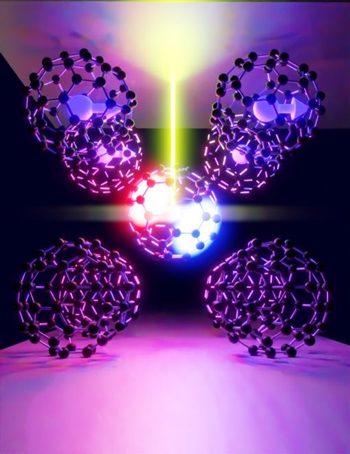ALBA Synchrotron

A study published in Advanced Functional Materials and led by researchers in the United Kingdom, in collaboration with BOREAS beamline at the ALBA Synchrotron, has proved the possibility to store magnetic information in picosecond timescales at a fullerene - oxide interface by using the photocurrent generated in the molecular layer.
This holds great potential for the development of eco-friendly, ultra-fast hybrid information memories and magneto-optic sensors working via light or electrical irradiation at high frequencies.
The amount of information stored and circulated doubles approximately every 2 to 4 years in what is known as the zettabyte era (the period in mid 2010s when the amount of digital data in the world first exceeded a zettabyte -2012- and when the global IP traffic first exceeded one zettabyte -2016-).
The power and resources required to sustain the exchange and storage of information represents a continually increasing percentage of the global resources. To make this progress sustainable in the coming decades, it is needed to find disruptive technologies operating at higher frequencies than the ones we use today (from MHz to THz) whilst reducing the operational power and promoting the use of eco-friendly materials. However, current devices frequently need of heavy metals and face limitations due to the speed of magnetization reversal and the current densities needed to store or switch information.
Researchers from the University of Leeds, in collaboration with the Science and Technology Facilities Council, the universities of Edinburgh and Exeter, and the ALBA Synchrotron, have published in the journal Advanced Functional Materials a new device architecture where the information is written using light instead of traditional methods such as magnetic fields in hard disks or electrical currents in solid state drives. That is achieved using a fullerene layer, a form of carbon such as graphene or graphite, sandwiched between a ferromagnetic metal and a transition metal oxide. In that material, light irradiation generates bounded pairs of holes and electrons (i.e excitons) that can be then separated using dielectric fields at each interface. These electrons and holes are finally spin-filtered, which generates a magnetic layer where the information is stored.
"Interfaces between molecules and metal oxides can give rise to functionalities no present in either material separately. This leads to novel functionalities, such a magneto-optic response that can be used for sensing or, as applied here, in low-power, ultra-fast memories. Multi-national collaborations and the support of large-scale facilities like ALBA will be key in studies to establish sustainable and resilient architectures for the future of technology" comments Prof. Oscar Cespedes, the leader of the research group from the School of Physics and Astronomy at the University of Leeds.
Synchrotron light, key for unveiling the magnetic details of memories
The researchers studied the electronic structure, which shows the formation of the dielectric fields and predicts a spin polarised molecular layer and a half-metallic metal oxide surface. Both of these were not linearly coupled with the cobalt electrode.
To study the change in photocurrent and magnetic properties when changing the light polarisation direction with the magnetisation, scientists used the capabilities of in devices before and after being charged. Changes can be measured via time-resolve measurements, and are apparent less than one picosecond after exposure.
"Future technologies rely on the miniaturisation of memory and logic devices operating at increasing frequencies. Our findings demonstrate a magnetic memory storage architecture localised to a functionalised interface that can exploit the picosecond time scales of optical excitations. The capabilities and expertise generated through our collaboration with the team from the BOREAS beamline were vital for interpreting our material system”, points out Dr. Matthew Rogers, the first author of the research paper.

Figure: a) A schematic picture of the structure showing the generation and filtering of electrons and holes when irradiated. The device can be charged and discharged using light and grounding the electrons. b) Photovoltaic distribution of the junction using a 50W 473nm laser. c) Hysteresis loop of the junction with the magnetic field parallel to the electrode (the easy magnetization axis, the one along which the material magnetizes with less energy).
With the collaboration of Fundación Española para la Ciencia y la Tecnología. The ALBA Synchrotron is part of the UCCs of the FECYT and has received support through the FCT-21-17088 project.